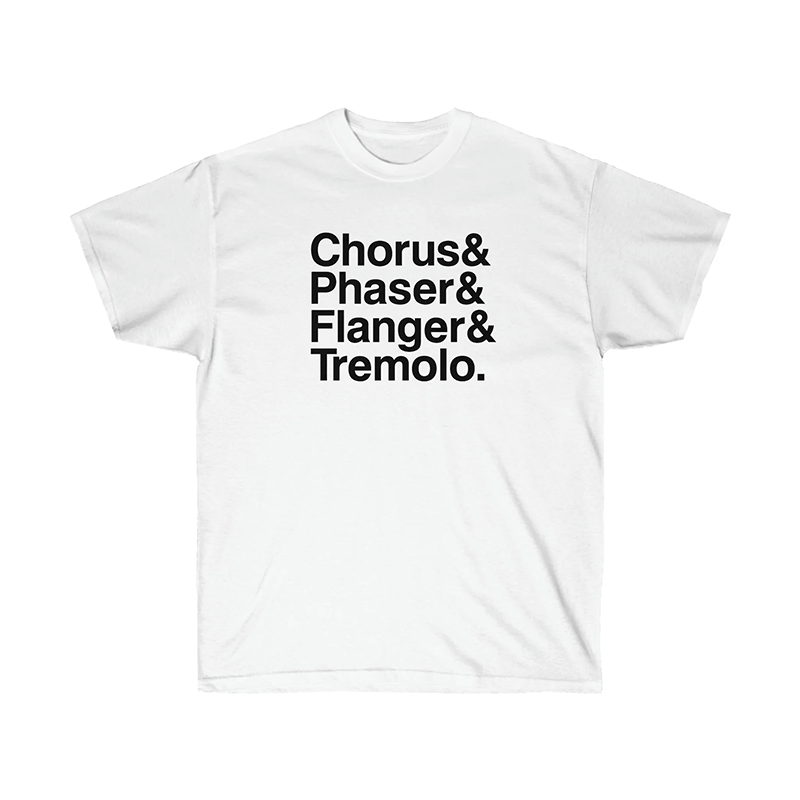I recently purchased the Monoprice Flanger Mini Pedal as a gift for someone else… Of course I couldn’t help myself, reaching for my guitar instead of the wrapping paper, and had to try it out. Based on the layout and comparing it to online audio samples, it’s most likely – if not definitely – the same exact circuit as the Donner Jet Convolution and the Mooer Eleclady, both of which are reported to be clones of vintage Electro-Harmonix Electric Mistress circuits.
(I tried to confirm the cloning issue with Monoprice prior to my purchase, but couldn’t get a definitive answer from the level 1 rep – but I’m betting it’s the same circuit, if not even made in the same factory.)
So if it’s essentially the same thing as the already documented Donner and Mooer, why is the Monoprice of note? If you already own or have tried either of the others, go ahead a skip to the end, but yes, this is even better than the competition.
For those of you coming in fresh, the Monoprice flanger is a must-try, no-brainer, sound manipulating AND sound generating secret weapon for any musician with experimental tendencies or just looking for something new to add to their rig.
Flangers remain misunderstood, underused, oft forgotten or even mocked. They shouldn’t be, but I suppose I can understand why they are. Think about the word – flange… Of the entirety of the FX lexicon – except for maybe the onomatopoetic ‘wah-wah’ – flange is probably the term least used in everyday, non-musical conversation. Delay, reverberation, distortion, feedback, sustain, phase, chorus – fairly common words. When was the last time you heard someone, a non-musician/plumber/carpenter, use the word flange in a sentence?
The etymology is nearly alien and the sonics can be too – if you want. The trick is putting it to good use.
I called this a secret weapon, it’s definitely deserving of that status. With in seconds of plugging in, I’d found a setting I’d liked – throughout the hour I let myself play, I’d dialed in enough different settings that I’d need to start taking notes to keep track of them all. When many players talk about flange, one of the first names/sounds to come up is Andy Summers of The Police – if Do do do da da da is what you’re looking for, the Monoprice has you covered. But for me, I think of Robert Smith and The Cure. The Monoprice Flanger is capable of a wide variety of 70s and 80s studio flange sonics, but it really satiates my appetite for those glassy, icy, desolate sounds of classic post punk and proto-goth tunes – I had to put on Seventeen Seconds while I draft this.
For three pots and a two-way toggle, there’s more possibilities than you’d imagine – especially if you’re coming in with few or only stereotypical expectations of flange. One position of the toggle lends itself to those thinner “post” sounds; the other is more buoyant, rubbery, watery sounds. On the thinner side, take the pots back counterclockwise and you can dial out all of the shimmer, gleam, and motion that is expected with a flanged sound, instead using the pedal as a filter – hollow bass tones on the fifth and sixth strings, made my normally chunky SG sound like a dry plinky bolt on (in a good way!), again perfect for aping that Cure sound, even some of the earlier 3 Imaginary Boys sounds. Turn the color up slightly, dig in with your pick and you’ll find touch-sensitive near-ring modulator sounds. Keep twiddling, faux chorus and phase sounds. Take the pots forward past noon, flip the toggle, and now those icy foundations have melted and you’re playing under water. Keep turning – slowly, at max settings it will oscillate – and it’ll sound like you’ve strung your guitar with rubber bands.
Adding other gear to the signal path and things get even more interesting. Stacking with dirt takes us back into secret weapon territory. The swoosh, that traditional jet plane sound, breathes new life into cascaded dirt chains for shoegazing and heavy Crazy Horse freak outs. Dial in more of that icy wash, almost like you would with a WNG, and use it as a sample source to feed a glitch/hold delay like the DD-3 or an old PDS/RDS series for generating obtuse ambient environs. Or put down the guitar and use the flanger as an instrument in and of itself. As the pots approach maximum the pedal can and will oscillate, feeding back on itself. Use these wailing siren horn haunted demon sounds to feed the rest of your chain and scare the neighbors will you drone/freak/psych bliss.
It’s compact. It’s sturdily built. It’s comically inexpensive. It’s true bypass. It’s also a damn near exact clone of two (or more, there’s more rebranded micro pedals out every week it seems) other TB, affordable, well built micro flangers – so why should someone buy the Monoprice over the other reasonable alternatives?
The Monoprice is better. It’s cheaper – on average $50 cheaper than the Mooer and a couple of dollars cheaper than the Donner (although it appears that Donner has dropper their price for the holiday buying season, when I bought the Monoprice it was more than $5 cheaper). Better customer service – Monoprice has a live chat option and same day shipping from the US, which, in my experience, means faster and more reliable delivery than items from Hong Kong post. Cosmetically, I really like the two tone look that Monoprice is using, much more striking than the flat colors of most of the other micro pedal brands.
But, most importantly, Monoprice has solved my biggest (and really only) complaint about micro pedals. If you’ve seen this tiny pedals, you’ve noticed their even tinier knobs. These knobs are impossible to see in the dark, on stage, and/or from any sort of distance or height. That may not matter if you’re a set-and-forget type, but with something like this flanger where you may have 3 or 4 different settings you want to exploit during a set, you need to be able to easily see the position of the pots to facilitate quick changes. Monoprice has put a simple white indicator line on the micro pots so you can actually see their position. Simple solution, but solving a big problem, taking these pedals from fun curiosities to gig worthy.
tl:DR. Improved VISIBLE mini pots, better than Donner and Mooer. Great secret weapon tool for experimentalists or anyone wanting 70/80s flange sounds. Bought as gift, buying at least one for myself.
Submitted by Dear Regency Elf, Website







